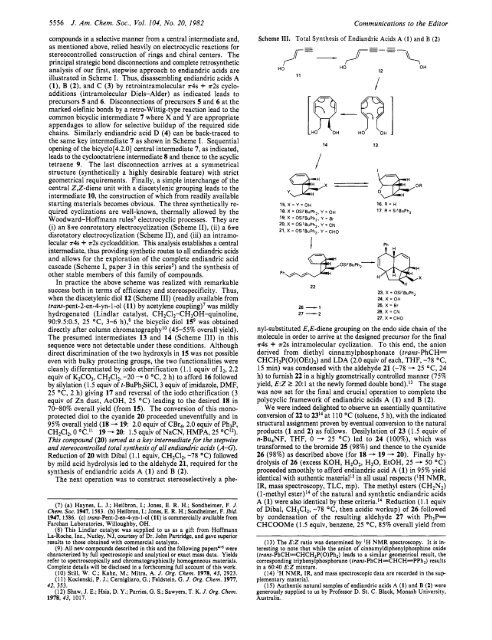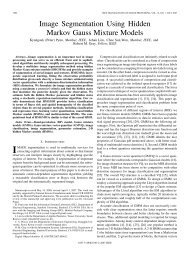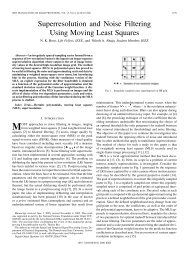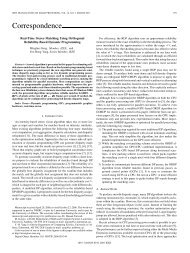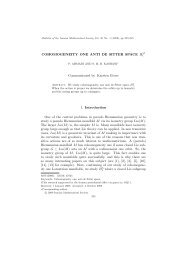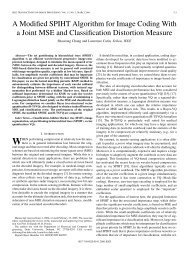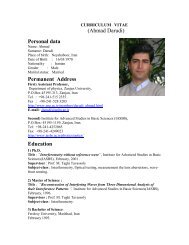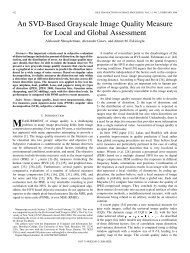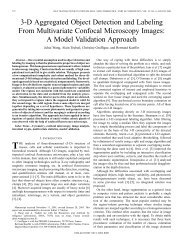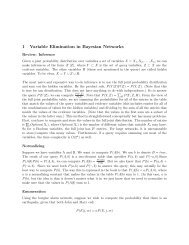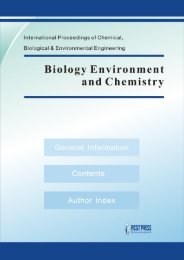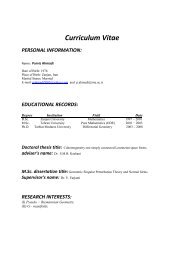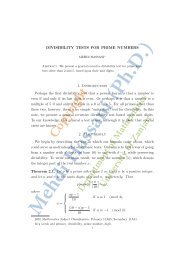The Endiandric Acid Cascade. Electrocyclizations in Organic ...
The Endiandric Acid Cascade. Electrocyclizations in Organic ...
The Endiandric Acid Cascade. Electrocyclizations in Organic ...
You also want an ePaper? Increase the reach of your titles
YUMPU automatically turns print PDFs into web optimized ePapers that Google loves.
5556 J. Am. Chem. SOC.. Vol. 104, No. 20, 1982 Communications to the Editor<br />
compounds <strong>in</strong> a selective manner from a central <strong>in</strong>termediate and,<br />
as mentioned above, relied heavily on electrocyclic reactions for<br />
stereocontrolled construction of r<strong>in</strong>gs and chiral centers. <strong>The</strong><br />
pr<strong>in</strong>cipal strategic bond disconnections and complete retrosynthetic<br />
analysis of our first, stepwise approach to endiandric acids are<br />
illustrated <strong>in</strong> Scheme I. Thus, disassembl<strong>in</strong>g endiandric acids A<br />
(l), B (2), and C (3) by retro<strong>in</strong>tramolecular r4s + s2s cyclo-<br />
additions (<strong>in</strong>tramolecular Diels-Alder) as <strong>in</strong>dicated leads to<br />
precursors 5 and 6. Disconnections of precursors 5 and 6 at the<br />
marked olef<strong>in</strong>ic bonds by a retro-Wittig-type reaction lead to the<br />
common bicyclic <strong>in</strong>termediate 7 where X and Y are appropriate<br />
appendages to allow for selective buildup of the required side<br />
cha<strong>in</strong>s. Similarly endiandric acid D (4) can be back-traced to<br />
the same key <strong>in</strong>termediate 7 as shown <strong>in</strong> Scheme I. Sequential<br />
open<strong>in</strong>g of the bicyclo[4.2.0] central <strong>in</strong>termediate 7, as <strong>in</strong>dicated,<br />
leads to the cyclooctatriene <strong>in</strong>termediate 8 and thence to the acyclic<br />
tetraene 9. <strong>The</strong> last disconnection arrives at a symmetrical<br />
structure (synthetically a highly desirable feature) with strict<br />
geometrical requirements. F<strong>in</strong>ally, a simple <strong>in</strong>terchange of the<br />
central Z,Z-diene unit with a diacetylenic group<strong>in</strong>g leads to the<br />
<strong>in</strong>termediate 10, the construction of which from readily available<br />
start<strong>in</strong>g materials becomes obvious. <strong>The</strong> three synthetically re-<br />
quired cyclizations are well-known, thermally allowed by the<br />
Woodward-Hoffmann rules3 electrocyclic processes. <strong>The</strong>y are<br />
(i) an 8re conrotatory electrocyclization (Scheme 11), (ii) a 6se<br />
disrotatory electrocyclization (Scheme 11), and (iii) an <strong>in</strong>tramo-<br />
lecular s4s + r2s cycloaddition. This analysis establishes a central<br />
<strong>in</strong>termediate, thus provid<strong>in</strong>g synthetic routes to all endiandric acids<br />
and allows for the exploration of the complete endiandric acid<br />
cascade (Scheme I, paper 3 <strong>in</strong> this series5) and the synthesis of<br />
other stable members of this family of compounds.<br />
In practice the above scheme was realized with remarkable<br />
success both <strong>in</strong> terms of efficiency and stereospecificity. Thus,<br />
when the diacetylenic diol 12 (Scheme 111) (readily available from<br />
trans-pent-2-en-4-yn- 1-01 (1 1) by acetylene coupl<strong>in</strong>g)' was mildly<br />
hydrogenated (L<strong>in</strong>dlar catalyst, CH2C12-CH30H-qu<strong>in</strong>ol<strong>in</strong>e,<br />
90:9.5:0.5, 25 "C, 3-6 h),8 the bicyclic diol 159 was obta<strong>in</strong>ed<br />
directly after column chromatographyI0 (45-55% overall yield).<br />
<strong>The</strong> presumed <strong>in</strong>termediates 13 and 14 (Scheme 111) <strong>in</strong> this<br />
sequence were not detectable under these conditions. Although<br />
direct discrim<strong>in</strong>ation of the two hydroxyls <strong>in</strong> 15 was not possible<br />
even with bulky protect<strong>in</strong>g groups, the two functionalities were<br />
cleanly differentiated by iodo etherification (1.1 equiv of 12, 2.2<br />
equiv of K2CO3, CH2C12, -20 - 0 "C, 2 h) to afford 16 followed<br />
by silylation (1.5 equiv of t-BuPh2SiC1, 3 equiv of imidazole, DMF,<br />
25 "C, 2 h) giv<strong>in</strong>g 17 and reversal of the iodo etherification (3<br />
equiv of Zn dust, AcOH, 25 "C) lead<strong>in</strong>g to the desired 18 <strong>in</strong><br />
70-80% overall yield (from 15). <strong>The</strong> conversion of this mono-<br />
protected diol to the cyanide 20 proceeded uneventfully and <strong>in</strong><br />
95% overall yield (18 - 19: 2.0 equiv of CBr4, 2.0 equiv of Ph3P,<br />
CH2C12, 0 OC.I1 19 - 20 1.5 equiv of NaCN, HMPA, 25 OClZ).<br />
This compound (20) sewed as a key <strong>in</strong>termediate for the stepwise<br />
and stereocontrolled total synthesis of all endiandric acids (A-G).<br />
Reduction of 20 with Dibal (1.1 equiv, CH2C12, -78 "C) followed<br />
by mild acid hydrolysis led to the aldehyde 21, required for the<br />
synthesis of endiandric acids A (1) and B (2).<br />
<strong>The</strong> next operation was to construct stereoselectively a phe-<br />
(7) (a) Haynes, L. J.; Heilbron, I.; Jones, E. R. H.; Sondheimer, F. J.<br />
Chem. Soc. 1947, 1583. (b) Heilbron, I.; Jones, E. R. H.; Sondheimer, F. Ibid.<br />
1947, 1586. (c) truns-Pent-2-en-4-yn-1-01 (11) is commercially available from<br />
Farchan Laboratories, Willoughby, OH.<br />
(8) This L<strong>in</strong>dlar catalyst was supplied to us as a gift from Hoffmann<br />
La-Roche, Inc., Nutley, NJ, courtesy of Dr. John Partridge, and gave superior<br />
results to those obta<strong>in</strong>ed with commercial catalysts.<br />
(9) All new compounds described <strong>in</strong> this and the follow<strong>in</strong>g paperse6 were<br />
characterized by full spectroscopic and analytical or exact mass data. Yields<br />
refer to spectroscopically and chromatographically homogeneous materials.<br />
Complete details will be disclosed <strong>in</strong> a forthcom<strong>in</strong>g full account of this work.<br />
(IO) Still, W. C.; Kahn, M.; Mitra, A. J. Org. Chem. 1978, 43, 2923.<br />
(11) Kocienski, P. J.; Cernigliaro, G.; Feldste<strong>in</strong>, G. J. Org. Chem. 1977,<br />
42, 353.<br />
(12) Shaw, J. E.; Hsia, D. Y.; Parries, G. S.; Sawyers, T. K. J. Org. Chern.<br />
1978, 43, 1017.<br />
Scheme Ill. Total Synthesis of <strong>Endiandric</strong> <strong>Acid</strong>s A (1) and B (2)<br />
HO<br />
7E- 7G-G-<br />
11<br />
14<br />
1 5, X = Y = OH<br />
18. X = OSi'BuPh,. Y = OH<br />
19. X = OSI'BuPh,. Y = Br<br />
20. X = OSi'BuPh,, Y = CN<br />
21. X = OSi'BuPh,, Y = CHO<br />
26 -1<br />
27 -2<br />
22 ~-<br />
HO<br />
I<br />
13<br />
12<br />
n -OR<br />
'\ OH<br />
16. R = H<br />
17. R = SI'BuPh,<br />
Ph<br />
I H<br />
23. X = OSi'BuPh,<br />
24, X = OH<br />
25. X = Br<br />
26, X = CN<br />
27, X = CHO<br />
nyl-substituted E,E-diene group<strong>in</strong>g on the endo side cha<strong>in</strong> of the<br />
molecule <strong>in</strong> order to arrive at the designed precursor for the f<strong>in</strong>al<br />
s4s + r2s <strong>in</strong>tramolecular cyclization. To this end, the anion<br />
derived from diethyl c<strong>in</strong>namylphosphonate (trans-PhCH=<br />
CHCH,P(O)(OEt),) and LDA (2.0 equiv of each, THF, -78 "C,<br />
15 m<strong>in</strong>) was condensed with the aldehyde 21 (-78 - 25 "C, 24<br />
h) to furnish 22 <strong>in</strong> a highly geometrically controlled manner (75%<br />
yield, E:Z I 20:l at the newly formed double bond).13 <strong>The</strong> stage<br />
was now set for the f<strong>in</strong>al and crucial operation to complete the<br />
polycyclic framework of endiandric acids A (1) and B (2).<br />
We were <strong>in</strong>deed delighted to observe an essentially quantitative<br />
conversion of 22 to 2314 at 110 "C (toluene, 5 h), with the <strong>in</strong>dicated<br />
structural assignment proven by eventual conversion to the natural<br />
products (1 and 2) as follows. Desilylation of 23 (1.5 equiv of<br />
n-Bu4NF, THF, 0 - 25 "C) led to 24 (loo%), which was<br />
transformed to the bromide 25 (98%) and thence to the cyanide<br />
26 (98%) as described above (for 18 - 19 - 20). F<strong>in</strong>ally hy-<br />
drolysis of 26 (excess KOH, H202, H20, EtOH, 25 - 50 "C)<br />
proceeded smoothly to afford endiandric acid A (1) <strong>in</strong> 95% yield<br />
identical with authentic material1* <strong>in</strong> all usual respects (IH NMR,<br />
IR, mass spectroscopy, TLC, mp). <strong>The</strong> methyl esters (CH2N2)<br />
(1-methyl ester)14 of the natural and synthetic endiandric acids<br />
A (1) were also identical by these criteria.I4 Reduction (1.1 equiv<br />
of Dibal, CH2C12, -78 "C, then acidic workup) of 26 followed<br />
by condensation of the result<strong>in</strong>g aldehyde 27 with Ph3P=<br />
CHCOOMe (1.5 equiv, benzene, 25 "C, 85% overall yield from<br />
(13) <strong>The</strong> E:Z ratio was determ<strong>in</strong>ed by 'H NMR spectroscopy. It is <strong>in</strong>terest<strong>in</strong>g<br />
to note that while the anion of c<strong>in</strong>namyldiphenylphosph<strong>in</strong>e oxide<br />
(trans-PhCH=CHCH2P(0)Ph2) leads to a similar geometrical result, the<br />
correspond<strong>in</strong>g triphenylphosphorane (trans-PhCH=CHCH=PPh,) results<br />
<strong>in</strong> a 60:40 E:Z mixture.<br />
(14) 'H NMR, IR, and mass spectroscopic data are recorded <strong>in</strong> the supplementary<br />
material.<br />
(15) Authentic natural samples of endiandric acids A (1) and B (2) were<br />
generously supplied to us by Professor D. St. C. Black, Monash University,<br />
Australia.


